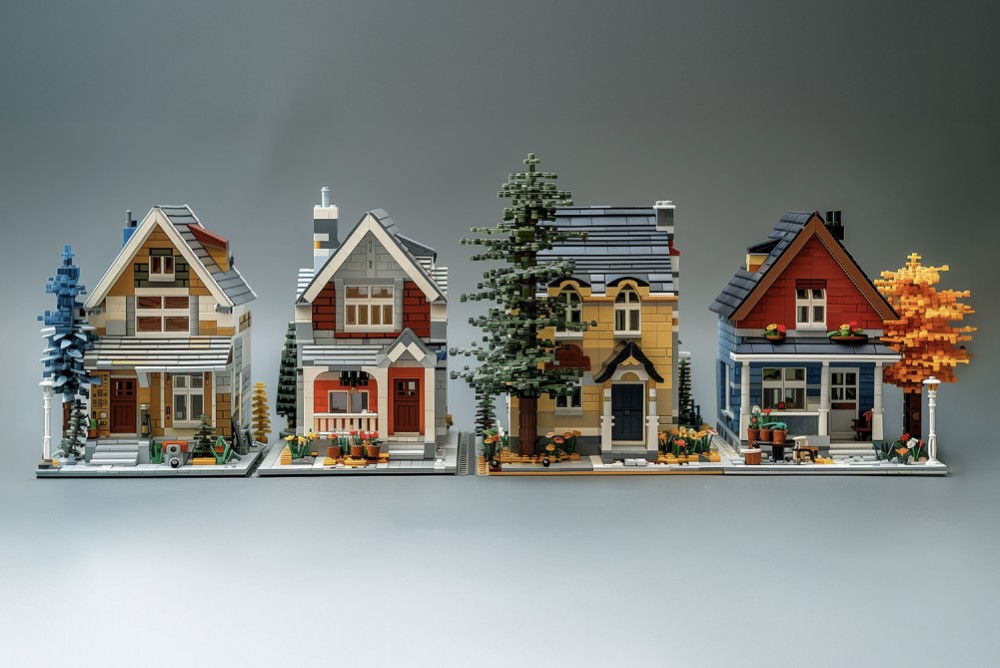Home styles of the Midwest
Here are some of the key home styles that shape Midwestern architecture in the heartland of America.
- American Craftsman. American Craftsman homes are known for their wide porches, low-pitched roofs, and exposed rafters. Iowa is recognized for its American Craftsman homes that emphasize handcrafted details and natural materials.
- Germanic. Germanic homes often feature sturdy construction, decorative woodwork, and steep roofs, reflecting the influence of German immigrants in the region. Wisconsin is known for its Germanic-style homes.
- Modern. Focusing on simplicity and functionality, modern homes often feature clean lines, open floor plans, and large windows. Michigan is known for its modern-style homes.
- Nordic. Inspired by the architectural traditions of Northern Europe, Nordic homes often feature minimalist design, functional use of space, and a connection to nature. Minnesota is recognized for its Nordic-style homes.
- Prairie. A variation of the prairie school (detailed below), a Prairie-style home is known for its strong horizontal lines, open floor plans, and integration with the landscape. Nebraska and North Dakota feature Prairie-style homes.
- Prairie School. Originating in the Midwest, Prairie School homes are characterized by their horizontal lines, flat or hipped roofs, and integration with the surrounding landscape. Illinois is known for its prairie school architecture. Meshing with the landscape is an attractive home feature, but it can also give intruders places to hide. A well-maintained landscape paired with plenty of outdoor security lighting can help.
- Ranch. Ranch-style homes are characterized by their long, low, ground-hugging profiles and open floor plans. They typically feature large windows, attached garages, and an emphasis on indoor-outdoor living. Kansas and South Dakota are known for their Ranch-style homes.
Building secure homes in the real world
From the Northeast’s colonial charm to the Midwest’s modern elegance, each style presents unique security needs. We encourage homeowners to remain vigilant and address potential risks, ensuring their homes are not only aesthetically pleasing but also secure.
As we leave you with these thoughts, here’s our list of practical security tips to protect your home.
Landscaping
- A well-maintained yard conveys an occupied, actively monitored home.
- Well-trimmed shrubs and trees near windows and doors provide better visibility, deter loitering, and protect against storm damage.
- Trimming large trees near a home deters intruders from accessing its upper levels.
- Large rocks can provide hiding places for burglars or, if located close to the home, an access point for them to enter the home.
- Storing flammable materials properly and away from the home's exterior reduces fire risks.
- Clearly defined property boundaries discourage unauthorized access and trespassing.
- Well-maintained fencing provides a robust perimeter deterrent against intrusion.
Lighting and visibility
- Proper outdoor lighting enhances visibility to identify approaching visitors.
- Motion-sensor floodlights illuminate dark areas, removing cover for burglars.
- Well-lit alleys and backyards enhance visibility and deter burglar activity.
- Using window coverings to obscure interior visibility deters casing by potential intruders.
Security and alarm systems
- Up-to-date security systems employ robust protective measures to stop intruders.
- Homes with alarm systems are less attractive targets for burglars.
- Security cameras enable active monitoring to detect and deter trespassers.
- A backup power supply ensures security systems remain operational during outages.
- Window glass break detectors trigger alarms immediately if something breaks the glass.
- Water sensor alarms provide early warning of flood risk, enabling quick response.
- Robust fire safety measures like alarms and extinguishers protect against fire damage.
- Motion sensors enhance detection capabilities to identify potential intruders swiftly.
Doors and windows
- Locking doors and windows is a simple but effective security precaution, and those in good condition are harder to force open.
- Peepholes and security chains on doors enable you to screen visitors safely.
- Securing balcony doors and reinforcing sliding doors eliminates easy access points.
- Reinforced glass or security doors prevent easy shattering for quick break-ins.
- Tempered window glass fortifies protection from severe weather and deters break-ins.
- Window privacy film prevents outsiders from seeing into the home interior.
- Tempered glass windows improve shatter resistance against break-ins or severe weather.
General safety
- Carbon monoxide detectors provide an early warning system against this poisonous gas.
- Having a reinforced storm shelter provides a safe haven during tornado emergencies.
- Maintaining the roof demonstrates active monitoring and deters perceptions of neglect.
- Having a fire escape plan in place prioritizes home occupant safety during emergencies.
- An active neighborhood watch program strengthens community security.
- Clearly posted security system signage acts as a visible deterrent to burglars.
- Using a safe secures and protects your most valuable possessions from theft.
- Storing tools inside prevents would-be burglars from using them to break in.
Methodology
All AI-generated images were created with DALL-E 3. This content is for entertainment purposes only.
About Vivint
Vivint is a leading smart home technology provider that offers innovative security, automation, and energy management solutions. Our state-of-the-art systems are designed to enhance the safety and comfort of your home.
Fair use statement
The information provided in this article is for non-commercial, educational purposes only. If you wish to share these findings, please ensure you provide a link back to this page for full access to the content and context.



